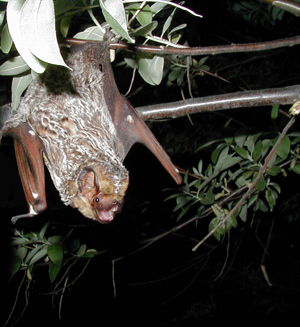Wind power takes a toll on migratory bats
Wind power takes a toll on migratory bats
But learning bat migration patterns may save them from wind turbines
Jeremy Hance
mongabay.com
September 12, 2007
The danger of wind turbines to birds has long been known and well documented. Most recently several studies and articles have attempted to place the level of bird casualties in perspective: “More birds killed by cats than wind turbines“. But lesser known—and lesser studied—is the effect wind turbines have on bat populations. Collisions between groups of bats and wind turbines have been observed at numerous turbines in America, Australia, and Europe. While these fatalities, sometimes killing hundreds of bats, have been seen for years, their cause remains unknown.
One fact is that the most affected bats are migratory species. These species make large seasonal migrations and spend the rest of their time roosting in trees. It is during the migrations that they are vulnerable.
Little is known about such migrations, but to glean information into why such bats are vulnerable to wind turbines and what might be done to safeguard them, two scientists, Paul Cryan and Adam Brown, recently studied migration patterns of the Hoary bat to Southeast Farallon Island, a small island off the coast of the San Francisco County.
 Hoary bat. Photo by Paul Cryan. |
Using previously recorded data, Cryan and Brown analyzed autumn migratory dates of the Hoary bats for thirty-eight years (the autumn migration always proved the deadliest). They looked at each migration for patterns in the weather: wind speeds, visibility, cloud cover, the amount of moonlight, and barometric pressure. The study discovered that Hoary bats did most of their migrating on nights when the sky was overcast, wind speeds were low, and the moon dark. A lower barometric reading was indicative of the arrival migration, but not the departure. From these findings, Cryan and Brown concluded that given more information the migration of bats may be predicted with some accuracy. Such predictions would help establish plans to minimize the damage to migrating populations from turbines.
More studies will be needed before solutions can be implemented, however. As Mr. Cryan states, “Unfortunately, I don’t think that anybody is in a position yet to make reasonable recommendations for reducing the number of fatalities. We just don’t know enough about why bats are colliding with turbines.” Mr. Cryan sees the need for further studies in three places if scientists are to achieve a breakthrough:
-
1) A more comprehensive picture of wind turbines is necessary, since researchers “currently have information on bats from about 10% of the existing wind energy facilities in the U.S. and Canada. We have very little information from states like Texas, New Mexico, and California where bat diversity is highest and turbines are being built in large numbers.” To achieve this researchers “need to the trust and cooperation of the wind industry”.
2) Further information on migration routes and times may be essential: “we need to learn how to predict if certain sites will be likely to kill bats before turbines are built and also to predict when bats are most likely to be killed at existing wind facilities.”
3) Finally, studies need to be undertaken as to why bats collide with turbines in the first place. Mr Cryan points out that “there is a growing body of evidence that suggests bats are attracted to wind turbines.” He is “hopeful that if we can figure out what it is that is attracting them, we can somehow eliminate the attractant.”
Though a distressing and new issue, wind turbines are not the only threat to bat populations. Years of pesticide use has taken heavy tolls on insectivorous bats, while timber roofs treated with toxic chemicals is another pollutant issue. Cavers disturbing bats amid hibernation can be devastating. Habitat loss continues to be a top threat—as it is with many species. Finally, these nocturnal flying-mammals are still greatly misunderstood; in some places species suffer systematic killing: people set fires inside caves or use shotguns to decimate what they consider a pest species.
CITATION: Paul M. Cyran and Adam C. Brown (2007). Migration of bats past a remote island offers clues toward the problem of bat fatalities at wind turbines Biological Conservation, Issue 139, I-II